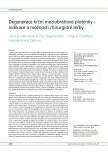Smell Perception Testing in Early Diagnosis of Neurodegenerative Dementia
Authors:
H. Magerová; M. Vyhnálek; J. Laczó; M. Bojar; J. Hort
Authors‘ workplace:
Neurologická klinika UK
; 2. LF a FN Motol, Praha
; Centrum pro poruchy kognitivních funkcí
Published in:
Cesk Slov Neurol N 2008; 71/104(3): 298-302
Category:
Original Paper
Overview
Objective:
The aim of this study is to investigate the rate and prognostic value of smell impairment in the most common types of dementia and in patients in prodromal stages of these diseases. We also present a new smell identification test developed at our Memory Clinic – the Motol Hospital Smell Test (MHST).
Subjects and Methods:
Based on the results of neuropsychological testing and MRI, 138 patients were classified into several groups as Alzheimer's disease (AD), Frontotemporal Lobar Degeneration (FTLD), Mild Cognitive Impairment (MCI) – amnestic (aMCI) and nonamnestic (naMCI), Subject Memory Complaint (SMC) and a control group. Smell identification was examined using MHST and the University of Pennsylvania Smell Identification Test (UPSIT).
Results:
Smell identification was significantly impaired in AD (p < 0.001), FTLD (p < 0.001) and aMCI (p <0.01) when compared to the control group. The naMCI and SMC patients did not differ from control group. MHST results correlated with UPSIT results (r = 0.68, p < 0.0005).
Conclusions:
Impaired smell identification in AD and aMCI and intact smell identification in naMCI correspondent with the hypothesis that aMCI represents a prodromal stage of AD, whereas naMCI typically converts to non-AD dementia. Results obtained by MHST and UPSIT show that sensitivity and specificity for assessment of smell identification impairment is at the same level in both tests.
Key words:
smell perception testing – Alzheimer’s disease – frontotemporal lobar degeneration – mild cognitive impairment – subject memory complaint – Motol Hospital Smell Test – University of Pennsylvania Smell Identification Test
Sources
1. Morgan CD, Nordin S, Murphy C. Odor identification is an early marker for Alzheimer’s disease: impact of lexical functioning and detection sensitivity. J Clin Exp Neuropsychol 1995; 17(5): 793–803.
2. Doty RL, Bromley SM, Stern MB. Olfactory testing as an aid in the diagnosis of Parkinson’s disease: development of optimal discrimination criteria. Neurodegeneration 1995; 4(1): 93–97.
3. Vodička J, Pokorný K, Ehler E, Pellant A. Poúrazová porucha čichu: kazuistiky. Cesk Slov Neurol N 2007; 70/103(6): 710–714.
4. Doty RL, Reyes PF, Gregor T. Presence of both odour identification and detection deficits in Alzheimer’s disease. Brain Res Bull 1987; 18(5): 597–600.
5. Mesholam RI, Moberg PJ, Mahr RN, Doty RL. Olfaction in neurodegenerative disease: a meta-analysis of olfactory functioning in Alzheimer’s and Parkinson’s diseases. Arch Neurol 1998; 55(1): 84–90.
6. Rezek DL. Olfactory deficits as a neurologic sign in dementia of the Alzheimer type. Arch Neurol 1987; 44(10): 1030–1032.
7. Feldman JI, Murphy C, Davidson TM, Jalowayski AA, Galindo de Jaime G. The rhinologic evaluation of Alzheimer’s disease. Laryngoscope 1991; 101(11):1198–1202.
8. Hawkes C. Olfaction in neurodegenerative disorder. Mov Disord 2003; 18(4): 364–372.
9. Nordin S, Murphy C. Impaired sensory and cognitive olfactory function in questionable Alzheimer’s disease. Neuropsychology 1996; 10: 113–119.
10. Nordin S, Almkvist O, Berglund B, Wahlund L. Olfactory disfunction for pyridine and dementia progression in Alzheimer disease. Arch Neurol 1997; 54(8): 993–998.
11. Murphy C, Gilmore MM, Seery CS, Salmon DP, Lasker BR. Olfactory thresholds are associated with degree of dementia in Alzheimer̉s disease. Neurobiol Aging 1990; 11(4): 465–469.
12. Koss E, Weiffenbach JM, Haxby JV, Friedland MD. Olfactory detection and identification performance are dissociated in early Alzheimer΄s disease. Neurology 1988; 38(8): 1228–1232.
13. Serby M, Larson P, Kalkstein D. The nature and course of olfactory deficits in Alzheimer΄s disease. Am J Psychiatry 1991; 148(3): 357–360.
14. Talamo BR, Rudel R, Kosik KS, Lee VM, Neff S, Adelman L et al. Pathological changes in olfactory neurons in patients with Alzheimer's disease. Nature 1989; 337(6209): 736–739.
15. Trojanowski JQ, Newman PD, Hill WD, Lee VM. Human olfactory epithelium in normal aging, Alzheimer's disease, and other neurodegenerative disorders. J Comp Neurol 1991; 310(3): 365–376.
16. Reyes PF, Deems DA, Suarez MG. Olfactory-related changes in Alzheimer's disease: a quantitative neuropathologic study. Brain Res Bull 1993; 32(1): 1–5.
17. Price JL, Davis PF, Morris JC, White DL. The distribution of tangles, plaques and related immunohistochemical markers in healthy aging and Alzheimer’s disease. Neurobiol Aging 1991; 12(4): 295–312.
18. Luzzi S, Snowden JS, Neary D, Coccia M, Provinciali L, Ralph MAL. Distinct patterns of olfactory impairment in Alzheimer’s disease, semantic dementia, frontotemporal dementia, and corticobasal degeneration. Neuropsychologia 2007; 45(8): 1823–1831.
19. Rami L, Loy TC, Hailstone J, Warren DJ. Odor identification in frontotemporal lobar degeneration. J Neurol 2007; 254(4): 431–435.
20. Hort J, Glosová L, Vyhnálek M, Bojar M, Škoda D, Hladíková M. Tau protein a beta amyloid v likvoru u Alzheimerovy choroby. Cesk Slov Neurol N 2007; 69/101(1): 30–36.
21. Braak H, Braak E. Neuropathological staging of Alzheimer-related changes. Acta Neuropathol 1991; 82(4): 239–259.
22. Devanand DP, Michaels-Marston KS, Liu X, Pelton GH, Padilla M, Marder K et al. Olfactory deficits in patients with mild cognitive impairment predict Alzheimer’s disease at follow-up. Am J Psychiatry 2000; 157(9):1399–1405.
23. Lopez OL, Becker JT, Jagust WJ, Fitzpatrick A, Carlson MC, DeKosky ST et al. Neuropsychological characteristics of mild cognitive impairment subtypes. J Neurol Neurosurg Psychiatry 2006; 77(2): 159–165.
24. Zatorre RJ, Jones-Gotman M. Human olfactory discrimination after unilateral frontal or temporal lobectomy. Brain 1991; 114 (Part 1A): 71–84.
Labels
Paediatric neurology Neurosurgery NeurologyArticle was published in
Czech and Slovak Neurology and Neurosurgery

2008 Issue 3
- Metamizole vs. Tramadol in Postoperative Analgesia
- Memantine in Dementia Therapy – Current Findings and Possible Future Applications
- Memantine Eases Daily Life for Patients and Caregivers
- Metamizole at a Glance and in Practice – Effective Non-Opioid Analgesic for All Ages
- Advances in the Treatment of Myasthenia Gravis on the Horizon
Most read in this issue
- Depersonalization and Derealization – Contemporary Findings
- Cervical Intervertebral Disc Degeneration – Surgical Treatment Indications and Options
- Migraine in Pregnancy
- Movement Activities in Patients with Inherited Polyneuropathy
